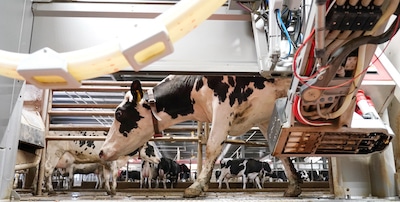I’ve never met a dairy farmer that wasn’t passionate about their cows. After all, cow comfort and care are at the top of the list for a successful business. But the dedication required and the 24/7 schedule is a commitment many of us would find hard to maintain. I experienced that dedication firsthand from my father (and mother) for 50 years. The advancement of milking equipment over the years improved the milking process but didn’t eliminate the time commitment. The twice daily milking (5 a.m. and 5 p.m.) with only family labor limits time off the farm (hence why my wedding was at 2:30 p.m.) and the ability to focus on other responsibilities. Likewise, it controls the cow’s schedule … even when she may not be ready.
Cows rule on any size of dairy farm but with advanced technology, like robotic milking systems, our four-legged females are the decision makers. The robotic system puts cows in control, making them more content, and dairy farmers more efficient in their care. Both are necessary for long term dairy farm success and ultimately, putting milk and dairy products on our table. We all love technology … and cows are no exception. Rockin’ the “robots” makes cows true bovine princesses.
What’s the Big Deal?
From child’s play to big screen movies and beyond, robots are not new. But what they can do continues to amaze. From simple household tasks to complicated surgical procedures, precision robotic technology improves efficiency and quality of any procedure. Robotic milking systems (RMS) are no exception.

Fair Oak Farms, 2019
The robotic milking technology system began in Europe during the early 1990s due to labor shortages. The technology migrated from Europe to the U.S. in 2000. I first saw a robotic milking system three years ago during a visit to Fair Oaks Farm. Fascinating as it was, I considered this as an option only for large dairy producers and not really for smaller herds.
However, a recent conversation with Marcia Endres, PhD, University of Minnesota Cooperative Extension Dairy Specialist, proved otherwise. Today, RMS are more common in the U.S., especially in the Upper Midwest and Northeast regions as dairy producers seek to improve cow comfort and efficiency. As Dr. Endres mentioned, “Robotic milking systems are tools that allow dairy producers to grow their business without increasing labor while creating flexible schedules for both themselves and the cows.”
Regardless of the dairy size, RMS are an option. Even though price is a factor, the efficiency of the system and the reduction of manual labor costs can help offset the expense. One robotic system will milk 50-60 cows over a 24-hour period. Dr. Endres said that one robotic system costs between $150,000 to $200,000.
How It Works

Robotic milking system at Heglar Creek Farms
Robotic milking is a voluntary milking system. Cows decide when they want to be milked and it works. According to Dr. Endres, the typical cow visits the milking station an average of 2.8 times per day, producing slightly more milk than in a more traditional setting. And, a “recent mother” cow may go to the robot four times daily! Cows, like people, have social norms. So more timid cows may lag and go to the RMS when fewer of their “sisters” are present. However, “laggers” are not the norm. According to Southern Idaho dairy farmer Josh Webb of Heglar Creek Farms, typically only 5-10% of his 1,000 cow herd using the RMS must be fetched at any time.
It’s About Data and Precision
The benefit of the robotic system is the extensive data provided for improved dairy management. Each cow’s sensor provides volumes of information! From tracking each cow’s milk composition to early detection of potential infection or breeding cycle, management and care of the dairy herd is improved. According to Josh, the vast amount of data contributes to decreased antibiotics use. Likewise, each cow’s nutritional needs are closely monitored with precision feedings customized to maximum their respective milk production. Even though less manual labor is required in the actual milking process, the success of the RMS requires a trained dairy management team to maintain constant technology checks and clean operations. In Josh’s operation, the data for each cow is checked twice daily to ensure the quality of the herd is maintained. As Josh mentioned, “Technology is great, but you still need to love cows … and have that cow sense.”
Technology is a Big Deal

Robotic milking system at Heglar Creek Farms
Why is this a big deal? Dairy farming is a labor-intensive business with unattractive hours. By using robotic milking systems, farmers can be more efficient with less manual labor while still improving the care of the cow — all elements that are critical to staying in business. Robotic technology rocks for cows and their human caretakers as flexibility and constant care on the farm improves quality of life for all … a benefit that all of us can share.
Acknowledgement: Special thanks to Marcia Endres, PhD, and Josh Webb for their time and insights, and Ann Lokuta, MPH, RDN, Health and Wellness Manager for Dairy West, for contacts and pictures. Check out Dairy West’s web-based continuing education library for other resources, including “Hear It From Your Local Farmer: Dairy Innovations & Technologies.”
Resources
- “Milking dairy cows with robots,” Marcia Endres, Extension Dairy Team Leader, and Jim Salfer, Extension Dairy Educator, University of Minnesota Extension.
- Robotic Milking, W.K. Kellogg Farm, Michigan State University.
- “We’ve Learned a Lot Over the Past 25 Years,” Lely Company.
- Follow Heglar Creek Farms on Instagram
